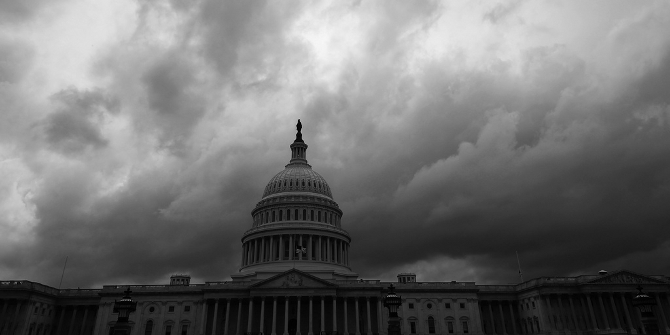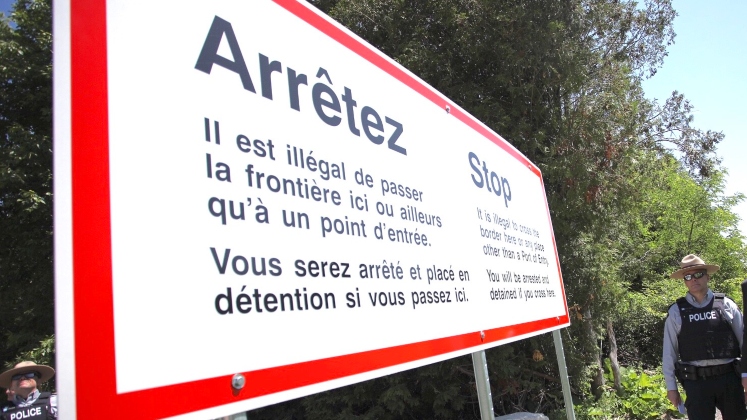

 Canada and the United States have the longest land border of any two countries, and much of it has relatively low levels of security. Karine Côté-Boucher, Luna Vives and Louis-Philippe Jannard look at the recent surge in asylum seekers crossing from the US into Canada at Roxham Road, a small country road linking Quebec and New York State. They write that its proximity to large urban and transportation centres on both sides of the border, as well as a loophole in the Canada-US Safe Third Country Agreement, mean that Roxham Road has become the main unofficial entry point into Canada. They argue that the growth of Roxham Road as an unofficial entry point into Canada despite efforts on both sides to restrict the arrival of asylum seekers – and a move to a ‘reluctant hospitality’ ethic in Canada – shows how borders cannot stop migration and that only policy can make it into a crisis.
Canada and the United States have the longest land border of any two countries, and much of it has relatively low levels of security. Karine Côté-Boucher, Luna Vives and Louis-Philippe Jannard look at the recent surge in asylum seekers crossing from the US into Canada at Roxham Road, a small country road linking Quebec and New York State. They write that its proximity to large urban and transportation centres on both sides of the border, as well as a loophole in the Canada-US Safe Third Country Agreement, mean that Roxham Road has become the main unofficial entry point into Canada. They argue that the growth of Roxham Road as an unofficial entry point into Canada despite efforts on both sides to restrict the arrival of asylum seekers – and a move to a ‘reluctant hospitality’ ethic in Canada – shows how borders cannot stop migration and that only policy can make it into a crisis.
Over 31,000 people have claimed asylum at the land border between Canada and the US this year. Virtually all of them did so at Roxham Road (Figure 1), a small, isolated country road about 300 miles north of New York City. While the numbers are small compared to those at the US-Mexico border, they are historically unprecedented: a “crisis”. How did Roxham Road become the main unofficial port of entry into Canada? And what are the consequences?
Figure 1 – Roxham Road, US-Canada Border

Map by Elizabeth Rose Hessek
A hostile border for asylum seekers
Canada has spent the last two decades reinforcing the border against spontaneous asylum seekers. The country’s “cold ocean geography” and location means that arrivals by sea are minimal. Instead, policy passed by successive governments since the early 2000s has zeroed in on airports and on the land border with the US – a country which is, effectively, Canada’s long border.
The 9/11 terrorist attacks in 2001 accelerated changes already in place. A range of measures (many included in the US-Canada Smart Border Action Plan) made it more difficult to reach the country by air. Increased visa requirements, Memorandums of Understanding with the US government on asylum claims and the penalization of airlines for improperly documented travelers are some examples. The Canada Border Services Agency (CBSA, the Customs and Border Protection’s younger counterpart) was created in 2003. Additional legislative and policy changes contributed to creating a more restrictive environment towards asylum seekers, while the country continued to relocate record numbers of refugees brought over from overseas.
Meanwhile, at the land border, the key development was the signing of Canada-US Safe Third Country Agreement (STCA, also part of the US-Canada Smart Border Action Plan) in December 2004. This agreement, modeled upon the EU’s Dublin regulations, requires asylum seekers to make their refugee claim in the first country of arrival. This means that, with some exceptions, asylum seekers presenting themselves at a Canadian a land port of entry will be sent back to the US.
Combined, these measures did result in lower numbers of asylum claims at the land border. As shown in the Figure 2 below, claims dropped by almost 70 percent between 2000 and 2005. But the results over the long term have been less clear, pointing to the importance of the larger geopolitical context – and, notably, to the links between events at Roxham Road and US asylum policy.
Figure 2 – Asylum seekers arriving at the Canadian and Quebec land borders (1997-2020)

For example, in 2016-2017, under Donald Trump’s Presidency, the US government threatened to remove protections for temporary groups already in its territory and cracked down on asylum seekers at the southern border. Prime Minister Justin Trudeau reacted with a Tweet, stating that Canada was welcoming to refugees. Almost overnight, asylum claims rose sharply at Roxham Road.
Why this forgotten country road? There is no official port of entry here. But Roxham Road is close to global transportation hubs in the US East coast and to Montreal, a Canadian urban center with a large immigrant population. It is also relatively safe to reach by bus and local taxi. Most importantly, asylum seekers who make their claim between two official ports of entry cannot be returned to the US under the STCA.

“Thank you to the RCMP who have been work…” (Public Domain) by Andrew Scheer
The border “crisis”
The US context and this “loophole” of the STCA created the perfect storm. Federal and provincial actors scrambled to respond to the arrivals, which saw an almost eightfold increase in just a few months. The crisis response that ensued dovetailed security concerns and compassion. The Quebec government requisitioned the Montreal Olympic Stadium to house asylum seekers during the Summer of 2017. The federal government had the military build emergency shelters near the border, hired the Red Cross to provide services at those shelters, brought the Royal Canadian Mounted Police (the national police service) to intercept border crossers, and redeployed CBSA officers to assist with asylum intakes. Many of the officers mobilized had little knowledge of or experience with the procedures they were asked to enforce.
And while different levels of government scrambled and community groups worked tirelessly to house, feed and provide the newcomers with residence and work permits, far-right anti-immigration groups such as La Meute surged. A provincial politician suggested that a fence be built at Roxham Road and a federal MP that Canada should prioritize the world’s most deserving refugees – those waiting patiently in refugee camps to be resettled.
Roxham Road’s legacy
Roxham Road caused a shift in the way asylum seekers are seen and treated in Canada. These are, according to the Geneva Convention and Canadian legislation, lawful asylum seekers. But, in the public imagination, they have become “illegal migrants” and “queue jumpers”. The legal and responsibility-centered approach that characterized Canadian asylum policy until the early years of the 20th century gave way to a reluctant hospitality logic. The question was not what were Canada’s obligations towards these people, but where were the limits to Canada’s “exceptional” hospitality? Asylum seekers were cast into the role of the humbled, indebted guest.
Wrapped in this was the perception that Roxham Road was a one-time crisis: with the proper policy and border enforcement instruments, Canada could go back to cherry-pick both its immigrants and its refugees. Almost 20 years later, the fantasy at the core of border control is laid bare: borders cannot stop migration. More fundamentally, Canada has been confronted with the political agency of asylum seekers and, more generally, with the continuing and intensifying reality of survival migration around the globe. Migration Studies teaches us that migration is a normal social fact, only policy makes it into a crisis.
If there is one thing to learn from these events, it is that the fantasy of containment will condemn us to an endless cycle of migration “crises”. The border may be the last line of defence, but it is useless to prevent the arrival of those with no choice but to pack up and leave.
- This article is based on the paper, ‘Chronicle of a “crisis” foretold: Asylum seekers and the case of Roxham Road on the Canada-US border’, in Environment and Planning C: Politics and Space.
- Please read our comments policy before commenting.
- Note: This article gives the views of the author, and not the position of USAPP – American Politics and Policy, nor the London School of Economics.
- Shortened URL for this post: https://bit.ly/3GHmP7h






